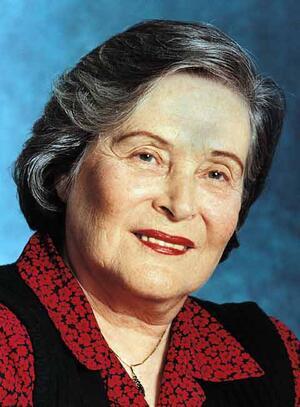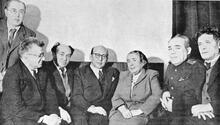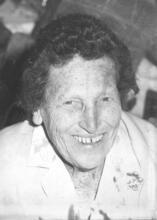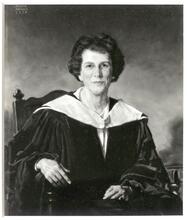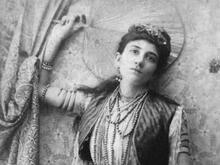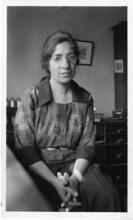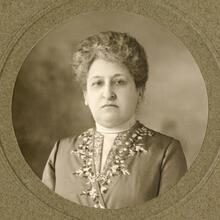Ruth Arnon
Immunologist Ruth Arnon and her team made unprecedented breakthroughs when they developed the first synthetic antigen and the first drug approved for treating multiple sclerosis, Copaxone. Arnon entered Hebrew University at age fifteen, doing her military service during summers while continuing her studies. She began working on her doctorate at Israel’s Weitzmann Institute of Science under Michael Sela in 1957. Over the following decades, she collaborated with Sela on numerous projects, culminating in the creation of Copaxone, which significantly reduces the frequency of MS relapses. Arnon also invented a synthetic, nasally administered flu vaccine and has published over four hundred articles, chapters, and books on immunology and biochemistry. In 2001 she won the Israel Prize for medicine.
One of Israel’s foremost scientists and immunologists, Professor Ruth Arnon is the incumbent of the Paul Ehrlich Chair in Immunology at the Weizmann Institute of Science in Rehovot. She was born in Tel Aviv on June 1, 1933. Her father, Alexander Rosenberg, was born in Brest-Litovsk (today Brest, Belarus) in 1898. In 1904, when he was six years old, his entire family, including his great-grandparents, left Belarus and settled in Petah Tikvah, where they owned a small orchard which provided an adequate income. Arnon’s maternal grandparents came to The Land of IsraelErez Israel from Russia in the 1880s, at the beginning of the First Lit. "ascent." A "calling up" to the Torah during its reading in the synagogue.Aliyah (1882–1903). They met on the boat, went to live in Jaffa and later married and moved to Neveh Shalom (a quarter in Tel Aviv near Jaffa). Their daughter, Sarah Perlman (1898–1983), was a graduate of one of the first classes of Lewinsky Teachers Seminary. Alexander Rosenberg and Sarah Perlman married in 1922.
Alexander Rosenberg served in the Jewish Legion during World War I and then went to Vienna to study at the Technische Hochschule. Scientifically inquisitive from an early age, he became particularly interested in electricity; in 1929, when he was already the father of two children, Nehama (b. 1923) and Avner (b. 1925), and his wife was working as a teacher, he went to Toulouse to study, taking the family with him. He completed his studies in electrical engineering in three years and also earned a master’s degree in mathematics. On his return to Palestine he began working as an electrical engineer for the Electric Corporation, where he was employed until the 1960s. He died in 1975.
Ruth Arnon ascribes her own urge to study to her father’s example. Ambitious and curious, she was taught reading and arithmetic by her older siblings while she was still in kindergarten and as a result was accepted straight into the second grade of elementary school. When she completed her schooling there at the age of thirteen, her mother succeeded in persuading Barukh Ben-Yehuda (1894–1990), the principal of the Herzlia Hebrew Gymnasia, to allow her to begin studying there. At the age of fifteen Arnon already knew exactly what she wanted to do, namely to work on the scientific basis of medicine. Although she wished to join a Nahal group (Fighting Pioneer Youth of the Israel Defence Forces) together with her comrades in the youth movement, when she graduated she was too young to be accepted and therefore registered at the Hebrew University of Jerusalem to study chemistry. A year later she joined the special academic study program, which enabled her to study during the academic year and spend her summers doing military training. In 1955, after receiving her M. Sc. degree, she served for two years as an officer in the IDF, during which period she married Uriel Arnon (b. 1930), an engineer who was at the time a student of chemical engineering at the Technion in Haifa. The couple has two children: Michal (b. 1957) and Yoram (b. 1961).
The Weizmann Institute
Learning that Professor Ephraim Katchalski (later Katzir, President of Israel from 1973 to 1978) was looking for scientists to carry out a new project, Arnon went to the Weizmann Institute, where she began work on her doctorate under the tutelage of Michael Sela (b. 1924), then a post-doctoral fellow who had recently returned from training in the United States, and became Sela’s first doctoral student in 1957. The two developed a close mentor-student relationship, worked together, published jointly in scientific journals and made their way up the Weizmann hierarchy. Sela served as President of the institute from 1975 to 1985 and Arnon served as Deputy President from 1988 to 1993.
During the course of their productive relationship, the two were partners in one of the most exciting discoveries at the Weizmann Institute. They succeeded in synthesizing, for the first time in the laboratory, a substance that aroused the body’s immune system, the first synthetic antigen. Together with another doctoral student, Devorah Teitelbaum, they discovered that a synthetic material produced in their laboratory could suppress a disease in animals that serves as a model for multiple sclerosis. Almost thirty years of research and experimentation elapsed between this pioneering discovery and the approval for medical use of Copaxone®, which has become a major drug for the treatment of multiple sclerosis and allows sufferers to lead near-normal lives. Copaxone is considered one of the great successes of the Israeli pharmaceutical industry. Arnon also invented a synthetic, nasally administered influenza vaccine, which is expected to be effective for several years against a broad range of flu virus strains.
Legacy
Ruth Arnon has published over four hundred articles, chapters, and books in the field of immunology and biochemistry.
Her many positions at the Weizmann Institute include Head of the Department of Chemical Immunology (1975–1978), Director of the MacArthur Center for Parasitology (1984–1994), Dean of the Faculty of Biology (1985–1988), Vice President (1988–1993) and Vice President for International Scientific Relations 1995–1997).
She has been a visiting scientist at The Rockefeller Institute, New York; University of Washington, Seattle; University of California, Los Angeles; Pasteur Institute, Paris; Walter and Elisa Hall Institute, Melbourne; Imperial Cancer Research Fund, London; Curie Institute, Paris and has been a Fogarty Scholar at the NIH, USA.
Her recent gift to create the Arnon Campus at the Weizmann Institute promises to transform science education in Israel.
Positions in Scientific Bodies
WHO Task Force on Immunological Methods for Fertility Control (Steering Committee, 1972–1977); President of the Israel Society for Biochemistry (1981–1983) President of European Federation of Immunological Societies (1983–1986); Secretary-General of the International Union of Immunological Societies (1989–1993); Elected member of European Molecular Biology Organization; Chairwoman of the Science Division of the Israel Academy of Sciences and Humanities (1995–2001); Member of the European Union Research Advisory Board (2001–2004); Vice-President of the Israel Academy of Science and Humanities (2004–); President of the Association of Academies of Sciences in Asia (September 2004–); Elected member of the American Philosophical Society (2009–); President of the Israel Academy of Sciences and Humanities (2010–2015); Co-chair of the UK-Israel Science Council (2017–).
She also serves as advisor for science to the President of Israel (2001–present).
Awards and Honors
Robert Koch Prize in Medical Sciences, Germany (1979); Jimenez Diaz Award, Spain (1986); Member of the Israel Academy of Sciences and Humanities (1990); Chevalier de l’Ordre de la Légion d’Honneur, France (1994); Hadassah Women of Distinction Award (1991); Wolf Prize (1998); Rothschild Prize (1998); Israel Prize in Medical Research (2001).

